
Duckworth Lewis Stern system is in use in the Huddersfield Cricket League.
Here's a useful guide to how it will be be implemented on a match day by umpires and DLMM's (Duckworth-Lewis Match Managers) and examples of the effect it may have on matches.

Viewing on a mobile device? The video is best viewed maximised in landscape view.
Watch how the Duckworth-Lewis calculator works in the ECB play-cricket Scorer app. This demo video is best viewed in full screen. Be aware the sample video uses the older DL format and not the current DLS calculation. However, the process is still the same.

Every club must have sufficient members capable of acting as Duckworth Lewis Match Manager (DLMM) such that one is present at every game. In practice this will usually be the home team scorer (or Primary scorer where electronic scoring is being used) or home team captain but by arrangement could be an umpire or another official from either team.

The umpires must confirm who will be the Duckworth Lewis Match Manager (DLMM) and availability of the Play-Cricket Scoring app (PCS).
If not using electronic ball-by-ball scoring the DLMM must use the standalone DLS calculator which is within PCS on iPhone and Android phones.

Umpires must note the time (plus overs completed, score, wkts and batsman on strike) at every suspension of play and then once they have decided that play will commence at a certain time, they must calculate the length of playing time that has been lost during that suspension break and whether or not any further overs have been lost from the game.

The umpires shall inform the DLMM of the number of overs lost in that suspension period before any recommencement of play giving DLMM time to record a new Suspension Break in PCS app.
On the expected resumption of play, The DLMM will be informed of the amount of overs lost during the Suspension Break by the umpire. The DLMM will then input this figure into the DLS calculator on the play-cricket scorer app shortly before play recommences.

If the 1st innings is complete, the Revised First Innings Total (RFIT) is calculated and displayed on the scoreboard where the normal First Innings Total is located, which should be checked by the umpires by the time play commences.
Important: The app reveals a target to be reached. Always display the revised first innings score as you would in a normal, uninterrupted match!
 Formulas For Calculating Overs Lost
Formulas For Calculating Overs LostTouch or click on each tab to reveal the content
On the initial rain interruption, first we must make a calculation of overs lost to work out our overs remaining figure...
Note: If overs remaining in either innings is less than 20, the match is abandoned.

We then make a second calculation and communicate the result to the DLMM and the scorer the overs remaining to display on the scoreboard.

On the initial rain interruption, first we must make a calculation of overs lost to work out our overs remaining figure...
Note: If overs remaining in either innings is less than 20, the match is abandoned.

We then make a second calculation and communicate the result to the DLMM and the scorer the overs remaining to display on the scoreboard.

 Umpires Guidance
Umpires GuidanceBasic Example - Part One.
| Match Type | League Match |
| Total Overs | 50 Per Team |
| Start Time | 1:00pm |
| Rain Stopped Play | 2:00pm |
| Innings Resumed | 3:15pm |


Basic Example - Part Three
| Match Type | League Match |
| Total Overs | 50 Per Team |
| First Innings Score | 206ao (43 Overs) |
| Second Innings Score | 120-9 (20 Overs) |
| Total Interruption | 72mins |
 As 20 overs have been bowled in the second innings and 24 overs have been lost, 24+20 is greater than or equal to the first innings overs played of 43 overs so therefore play is complete. Because 20 overs have been completed, a result will be calculated by the DLMM.
As 20 overs have been bowled in the second innings and 24 overs have been lost, 24+20 is greater than or equal to the first innings overs played of 43 overs so therefore play is complete. Because 20 overs have been completed, a result will be calculated by the DLMM.
Another useful calculation can determine how long an interruption before the match must end. When the players leave the pitch 20 overs have been bowled out of a maximum of 43 overs. 23 overs remain to bowl.
 Result
ResultOnce 72 minutes have passed, the 23 overs has reduced to zero and the match will be concluded.
Moderate Example - Parts One and Two
| Match Type | League Match |
| Total Overs | 50 Per Team |
| Start Time | 1:00pm |
| Rain Stopped Play | 1:45pm / 10 Overs |
| Innings Resumed | 5:15pm |


| First Innings Conclusion | 6:15pm / 25 Overs |
| Second Innings Starts | 6:25pm |
| Rain Stopped Play | 6:30pm / 1 Over |
| Innings Resumption | 6:47pm |
| Total Interruption | 17 mins |


Any further interruptions from here would conclude the match as 20 overs would not be completed.
 DLMM Guidance
DLMM GuidanceBasic Example - Part One and Part Two
| Match Type | League Match |
| Total Overs | 50 Per Team |
| Start Time | 1:00pm |
| Rain Stopped Play | 2:00pm |
| Innings Resumed | 3:15pm |
| First Innings Score | 40-1 (16 Overs) |
Umpires advise there are 27 overs remaining following a 'time lost' calculation
Using the play-cricket Scorer app, in the TOOLS area (without logging in) there is a D/L calculator for use by the DLMM during matches scored manually. Once an interruption occurs, the DLMM enters info given by the umpire as in the following examples:

The innings has been completed at 200-5 after 43 Overs, including the interruption above which has been logged.
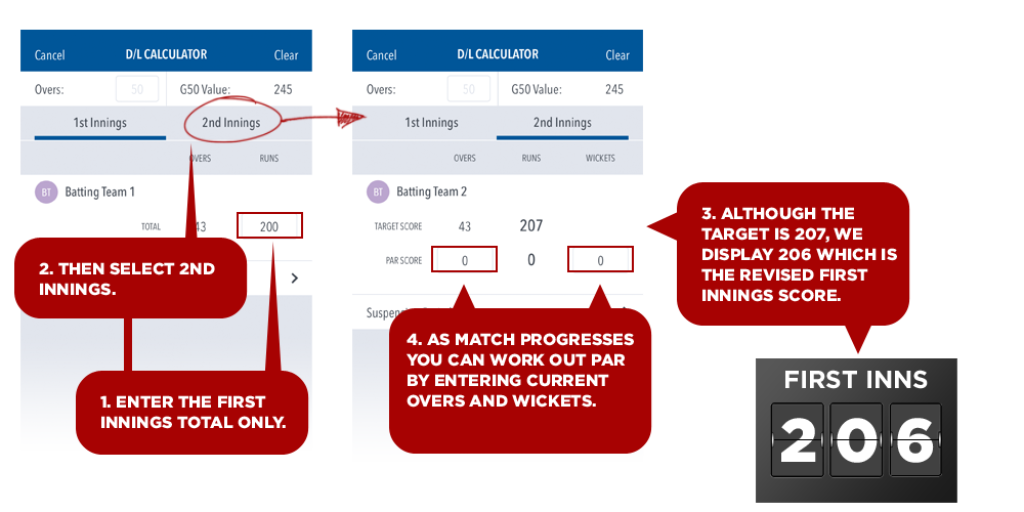
Note: Should the match suffer a further interruption in the second innings, you can use the par score to calculate who is 'winning' at that point. Useful for team officials or supporters to keep track in-play.
Basic Example - Part Three
| Match Type | League Match |
| Total Overs | 50 Per Team |
| First Innings Score | 206ao (43 Overs) |
| Second Innings Score | 120-9 (20 Overs) |

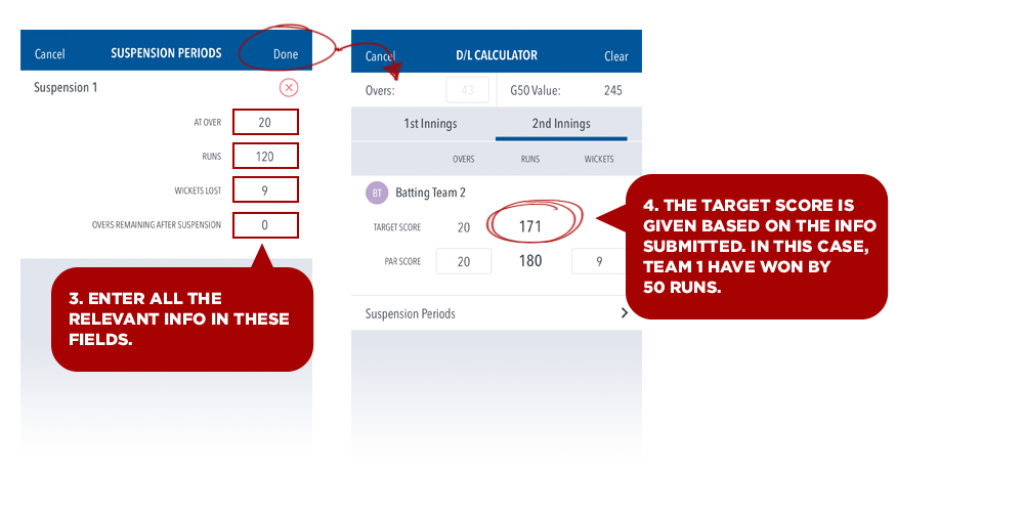
Basic Example - Part Three
| Match Type | League Match |
| Total Overs | 50 Per Team |
| Start Time | 1:00pm |
| Rain Stopped Play | 1:45pm |
| Innings Resumed | 5:15pm |
| Resumed Score | 50-1 (10 Overs) |
| First Innings Total | 150ao (25 Overs) |
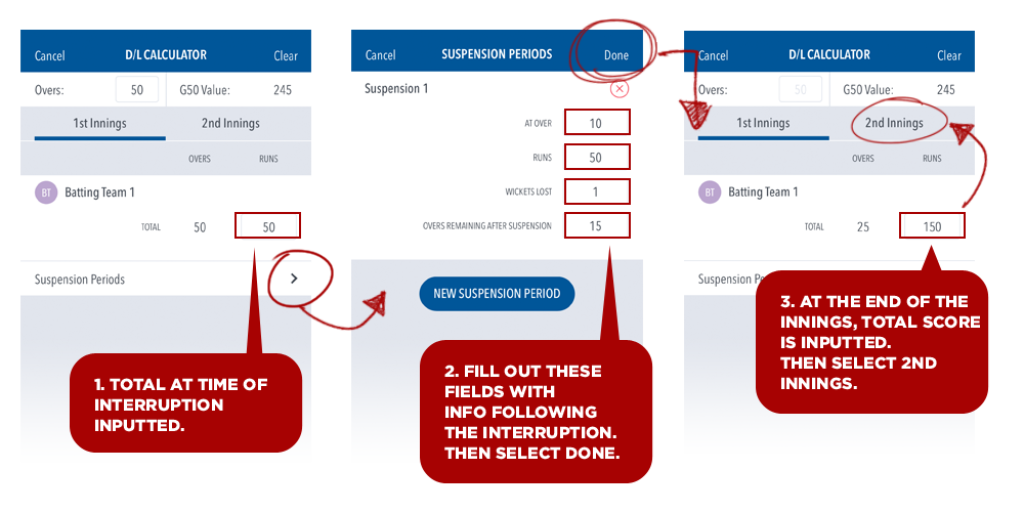
| Innings Closed | 6:25pm |
| Second Innings Commenced | 6:35pm |
| Adjusted First Innings Score | 166 |
| Adjusted Overs Remaining | 25 Overs |
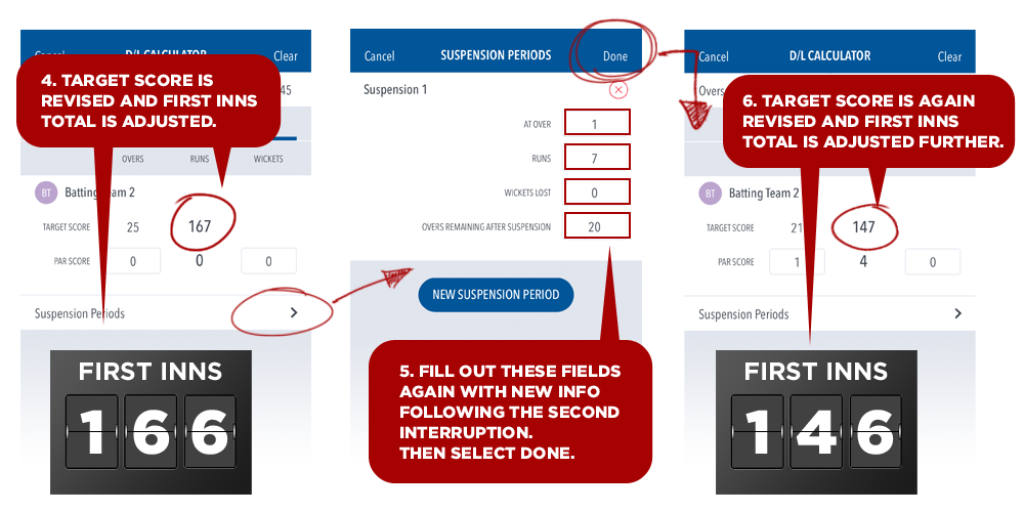
A 50 over League game which started on time at 1pm.
Rain stops play at 2pm with score 40/1 off 16 overs.
Play re-starts at 3:15pm then time lost is 75 mins.
The first 30mins lost within a game is ignored so 75-30=45mins lost
At 1 over per side for every full 6mins lost we remove 45/6 = 7overs per side.
Umpire must note the overs remaining in the innings as 27. 50-16-7=27.
Umpire should check that scoreboard is showing 27 overs upon resumption of play.
RESPONSIBILITY OF THE DLMM
Before any recommencement of play, the umpires shall inform the DLMM of the number of overs lost in that suspension period, giving DLMM time to record a new Suspension Break in PCS app and, if the 1st innings is complete, to calculate the Revised First Innings Total (RFIT) and set the scoreboard which should be checked by the umpires before play commences.

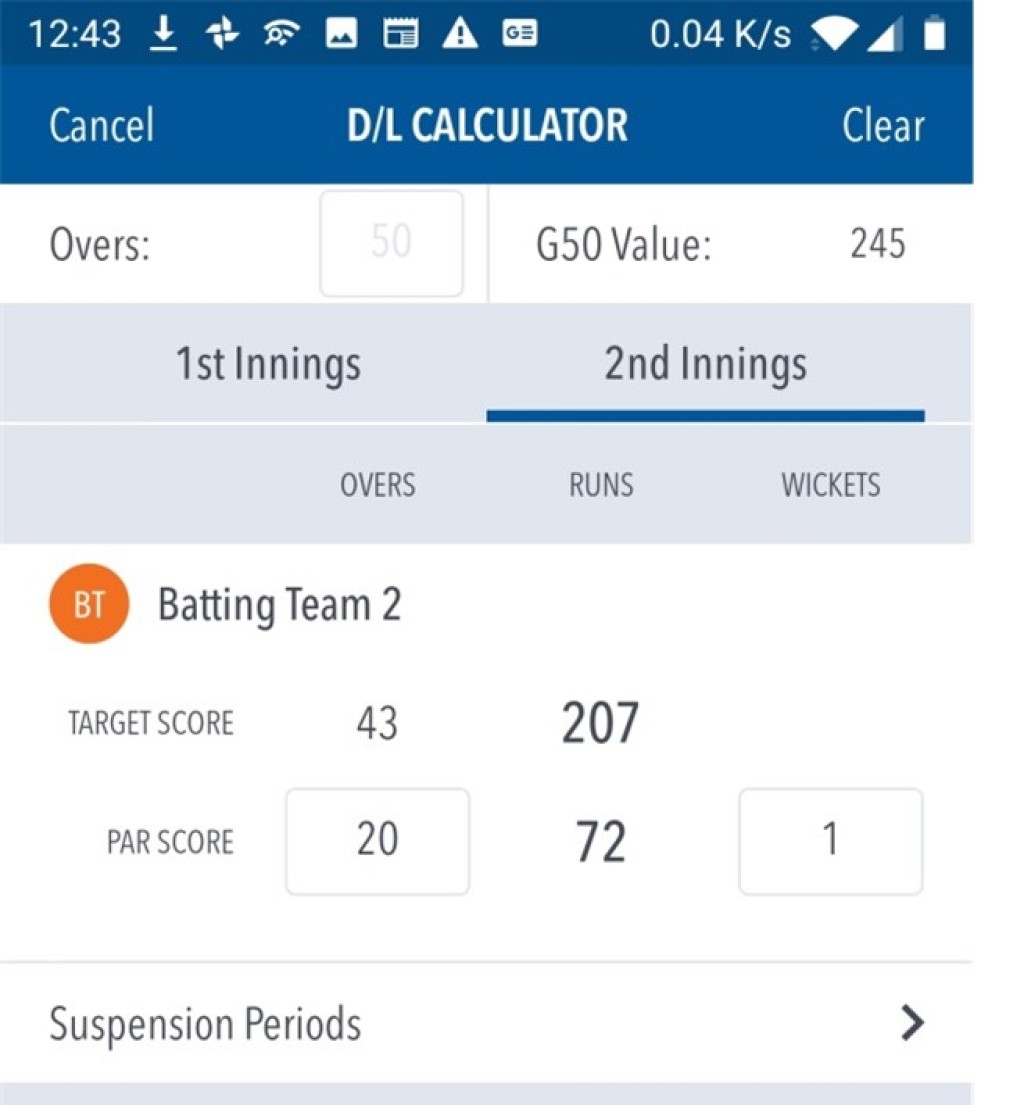
Umpire will inform the DLMM that 27 overs are remaining in 1st innings. The DLMM will set the switch to state that DL is now in operation and will record Suspension Break 1 as:-
* overs gone= 16 runs= 40 wkts= 1 overs remaining= 27
This will NOT give a revised 1st innings total until the 1st innings is complete.
First innings concludes at 200/5 off the new limit of 43 overs. As part of ball-by-ball scoring closing the 1st innings will reveal a Target (score to win) of 207 which is one more than the Revised First Innings Total of 206 which must be shown on the scoreboard.
NOTE – DO NOT DISPLAY TARGET ON THE SCOREBOARD
If using the DL standalone calculator the 1st innings total must be entered to reveal the Target from which the RFIT is derived.
During second innings Rain Stops Play with score at 120/9 off 20overs
With 23 overs to go and 2 overs to lose for every full 6mins then once 72mins have been lost the game is concluded and Umpires will inform the DLMM to enter a new Suspension Break
* overs gone= 20 runs= 120 wkts= 9 overs remaining= 0
This will reveal a Target of 196 or RFIT of 195 and so, as 20 overs have been completed the team batting first have won by 75 runs under DL.
You are recommended to download the PCS app onto a Smartphone and follow Tutorial 5 – Duckworth Lewis. Note that once you have opened the PCS app you do NOT need to login to use either the Tutorials or the Standalone DL calculator.
Once you have followed the tutorial you should click on Tools from the home page and that will allow you to select the Standalone DL calculator. You could run the above and following examples on the Standalone DL calculator.
A 50 over League game which started on time at 1pm.
Play was suspended at 1:45 with score at 50/1 after 10 overs
Play to restart at 5:15
Therefore time lost is 3:30 or 210mins
Tea was taken at 4:00 for 30mins
Therefore Playing Time lost was: 210-30(tea)=180mins
HCL have a post-start waiver time of 30mins in League games and as this was the first stoppage the overs to be lost is calculated (1 lost in each innings for every full 6mins) as: 180 - 30(remaining waiver time) = 150 / 6 = 25
Umpires have sole responsibility for deciding these stop and re-start times.
DLMM records Suspension Break 1 as:-
* overs gone= 10 runs= 50 wkts= 1 overs remaining= 15
The 1st innings concludes at 150/3 off 25 overs
DLMM records 1st innings total of 150 and clicks 2nd innings to reveal Target.
Note that both innings are reduced to 25 overs and that although the first team scored 150 the Target is calculated at 167 to win and so for compatibility with a game in which there has been no interruption, the scoreboard should show at start of 2nd innings that overs remaining is 25 and first team total is 166 (i.e. score to tie). There will be a 10min interval between innings but as this is a scheduled break it will NOT be considered to be a suspension break.
If you are running this example on PCS and are at the screen which shows the Target of 167, you will note the Par score showing 0overs/0runs/0wkts where you can edit the overs and wkts. If you change the overs to 20 the runs will change to 123 and if you then change the wkts to 9 the runs will change to 154. These figures are showing that if the game was rained off after 20 overs scores of 123/0 or 154/9 would result in a tie.
First innings was completed at 6:15 with score on 150/3 (wkts lost is actually irrelevant when there has been no loss of overs immediately prior to end of innings).
Second innings commences at 6:25 with scoreboard showing a RFIT of 166 with 25 overs remaining, as calculated in first part of example.
After completion of first over at 6:30 with score on 7 for 0 play is suspended
Play re-commences at 6:47 – this is actually the latest time play could re-commence otherwise 20 overs would not be possible and game would be abandoned.
17mins playing time has been lost.
Note: rate is same as first innings with same minimum of a full 6mins but as you are no longer losing an over from each innings the overs lost in 2nd innings will be in pairs of overs. So 17/6 = 2 pairs of 2 overs = 4 overs lost. It is now a 21overs innings with 1 completed and 20 remaining.
A new Suspension Break must be entered (DO NOT EDIT THE PREVIOUS SUSPENSION BREAK but note that the breaks are numbered from 1 in each innings) as follows:-
* overs gone= 1 runs= 7 wkts= 0 overs remaining=20
Target re-calculates at 147 from, in total, 21 overs. The scoreboard should display a Revised First Innings Total of 146 with 20 overs remaining.
There is no fixed time for conclusion of play but in worst case this example should conclude approx 8:15 but if there is another delay the game will be abandoned because otherwise there would not be 20overs available even if very few runs or wickets were required at the time of the delay.
A 50 over League game scheduled to start at 1pm.
*Start delayed until 1:17pm
17mins late. Therefore 17/6 = 2 overs deducted from each side i.e. 48overs per side
Play suspended at 1:40pm score is 21/1 off 7overs
*Play re-starts at 2:00pm
20mins interruption is less than 30mins waiver time (before DL is implemented) therefore no loss of overs.
Play suspended at 2:30pm score is 50/2 off 15overs
*Play re-starts at 2:45pm
15mins interruption + 20mins total to date = 35mins which is 5 mins in excess of waiver time. 5mins is less than the 6mins minimum so 0 overs lost but DL is now in operation if any more overs are lost.
Play suspended at 3:30pm score is 100/2 off 25.2overs
*Play re-starts at 4:45pm with continuation of the 26th over.
75mins interruption. DL is now in operation so each interruption is taken in isolation. This will require the recording of a first Suspension Break (SB1) as 75/6 = 12 overs to be reduced from each team making it a 36 overs per team game.
* Suspension Break 1 overs gone= 25.2 runs= 100 wkts= 2 overs remaining= 10.4
Play suspended at 5:25pm score is 170/4 off 34.5 overs due to rain when 4th wkt fell.
Once off the field for 6mins the 1st innings is closed because you cannot return for less than a full over so Tea will be taken and play will be scheduled to re-start at 6:01pm but nominally 6:00pm.
A new Suspension Break (SB2) will be recorded as
* Suspension Break 2 overs gone= 34.5 runs= 170 wkts= 4 overs remaining= 0
This will give a Target of 202 off 34.5 overs but as an innings can only be scheduled for a full number of overs, once the 1st innings has been closed, a new Suspension Break must be recorded, before 2nd innings commences, as:
* Suspension Break 1 overs gone= 0 runs= 0 wkts= 0 overs remaining= 34
This will give a Target of 199 off 34 overs but RFIT of 198 is to be shown off 34 overs on scoreboard.
Play re-starts at 6:00pm with commencement of a 34 over 2nd innings
Play suspended at 7:30pm score is 101/2 off 25.2overs
No further play is possible during the next 30mins so game is concluded with the entry of another Suspension Break.
* Suspension Break 2 overs gone= 25.2 runs= 101 wkts= 2 overs remaining= 0
DL will return a Target (to win) of 133 therefore 1st team to bat have “won by 31 runs under DL”
Note – prior to entering Suspension Break 2 the DL calculator will be showing Target 199 off 34 overs and you will be able to see the Par Score (score to tie same as RFIT) for any combination of overs and wkts you care to enter. E.g. 25.2overs gives a Par score of 130/1, 132/2 and 134/3 while 26 overs gives a Par of 136/2